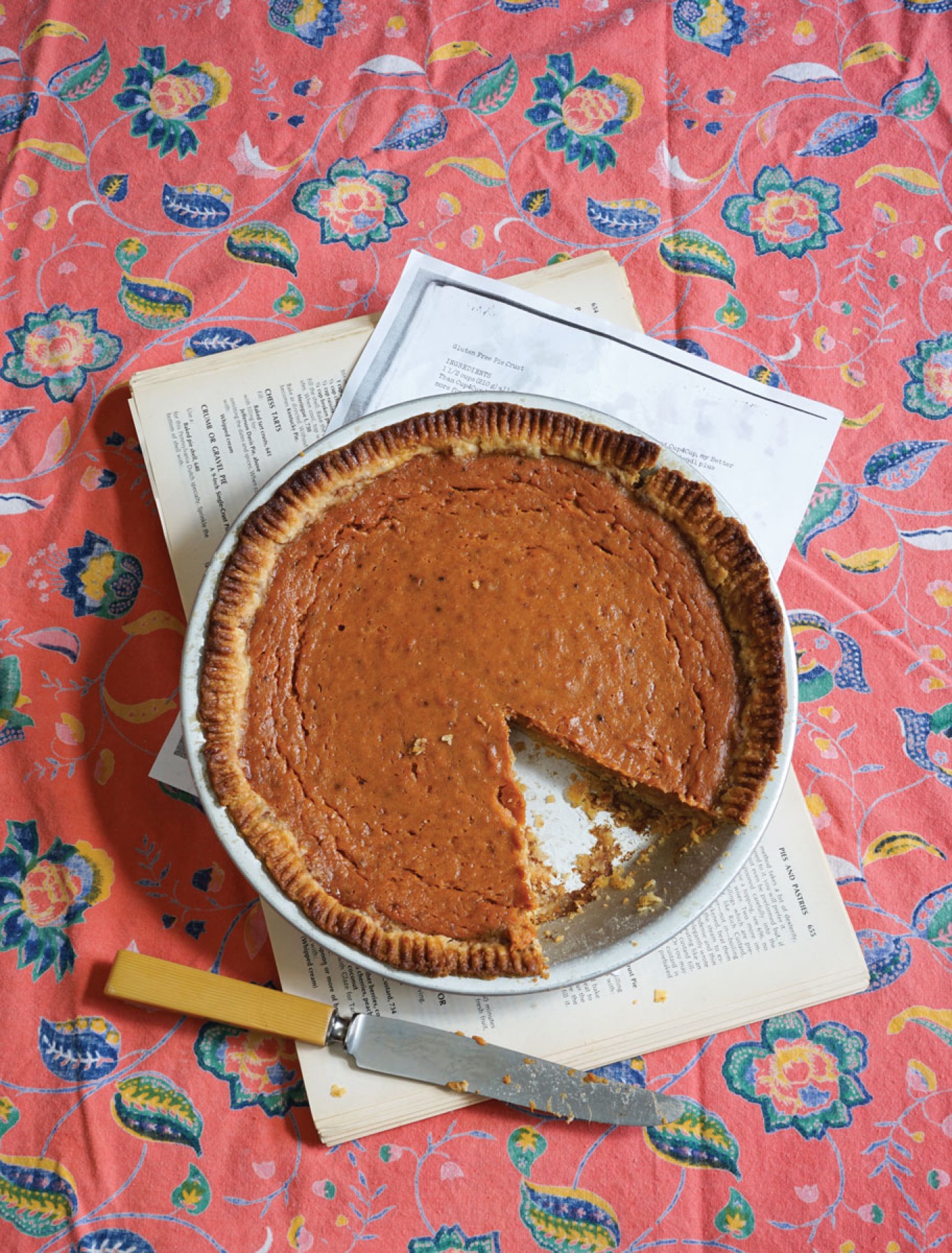Loving Something Enough
By Tiana Clark

Photograph by Milton Carter
It was after my husband moved out and suffered what the doctor called “an emotional heart attack.” It was after I came back to Nashville because my father-in-law had a near fatal stroke with devastating deficits. It was after my husband was carjacked and shot in the arm. It was after—days later, still in shock—I interviewed Ta-Nehisi Coates onstage at a downtown theater in front of seven hundred people about his first novel, which mixes magical realism with a slave narrative about love and the memory of water, when I decided to make my first sweet potato pie.
It was November 2019, and I decided to make a gluten-free crust from scratch—my first mistake. I bought the special flour and made sure the butter was cold. I had my recipe printed out and on the counter.
It was the night before Thanksgiving. A few months earlier, in June, my husband and I had decided to divorce. The details aren’t relevant; the divorce was amicable, but difficult nonetheless. I wanted to have a last Thanksgiving while we were technically still married, a way to say goodbye with some kind of protracted ritual, with lots of cooking and carbs. I thought we needed to grieve together—that was my second mistake.
I didn’t think a pie, especially a gluten-free one, would save my marriage. I knew it was over, but I had been working on self-care and self-love and all the “self-” stuff you do after a massive trauma ruptures your life with a psychological sinkhole. Yes, I desired to make and bake a pie, but more than that, I was trying to re-parent and ground myself, make something sweet and intentional with my hands. I wanted to try a new and comforting endeavor, and nothing is more comforting than a slice of homemade pie: a warm hug in your mouth, good and hearty, indulgent even; a richness for your soul.
I had never made a pie from scratch, and it intrigued me to create a slow and tedious dessert within the confines of a kitchen. I craved a nurturing act, replete with love. Pie means something different to all of us, but I think for me, making a sweet potato pie meant I had some tactile way to manipulate my grief and gratitude. The act also felt personal: Sweet potato pie is a Southern tradition, and a very Blackity, Black-Black one at that. Growing up, I ate my auntie’s slice of dark-orange heaven with notes of brown sugar and nutmeg every Thanksgiving.
“Sweet potato pie is the ‘sacred dessert’ of Black people, and it has power,” said Rose McGee, who drove down to South Carolina from Minnesota in a car packed with fifty-six sweet potato pies after the nine Black churchgoers were murdered at the Emanuel African Methodist Episcopal Church in Charleston. “Not only does it give us energy, this pie links us to history, it soothes our spirits and renews us for the much-needed work.” Her Sweet Potato Comfort Pies project brings healing to grieving communities through the love of the classic soul-food dessert—places like Ferguson, Standing Rock, and recently Minneapolis after the murder of George Floyd. Sweet potato pie is deeply linked to African-American nostalgia, to home, and to the traditions of the Deep South, especially after the Great Migration. James Beard Award–winning author Adrian Miller writes in his book Soul Food: The Surprising Story of an American Cuisine, One Plate that “cooking is an act of love at the most basic level. Somebody is saying they care about your survival. I think sweet potato pie means that to a lot of people.”
I followed the recipe’s instructions exactly, but every time I went to drape the dough over my ceramic pie pan, it disintegrated, crumbled like wet, soft sand between my flour-flecked fingers—the dough would not yield to me. I would smoosh the pale-yellow Play-Doh monster into a blob and pop it in the freezer for ten more minutes, then roll it out again—and, again, the same result: gloppy dough chunks. The crust refused to hold a circular shape. I tried, failed, wrestled, reckoned, cried, and then pleaded with that damn intractable dough for hours, until it was 3 a.m. In a Sisyphean burst of bright kitchen rage, I threw the overworked pie dough on the hardwood floor—splat! Flour sprinkled everywhere like snow: on the counters, on my cheeks and hair. The whole pitiful scene was a messy metaphor I wasn’t ready to name, taunting me that nothing was working out the way I wanted it to. George Washington Carver said, “Anything will give up its secrets if you love it enough,” but I wonder if Carver ever baked with gluten-free flour. Maybe that was my third mistake: I was too fixed on the outcome.
In her poem “The Wild Iris,” Louise Glück writes, “At the end of my suffering / there was a door.” And, in “Love Poem,” she writes, “There is always something to be made of pain.”
At the end of my pain there was a pie crust on the floor.
I was trying to make something delicious out of my sorrow, but sometimes you just have to laugh at your pitiful self. I shellacked the stubborn dough into the form of a patchwork pie crust, working the dough bits like malleable cloth sections for a quilt. With little hope, I poured in the sweet potato filling and baked the pie. When it came out of the oven it looked alright—edible—but the crust was impenetrable. My knife couldn’t even cut through the bottom crust, which was hard as a Frisbee. I ate the pie by scooping out the filling in defeat, scraping my spoon along the stubborn, unbreakable crust.
The other day, my friend Ciona Rouse and I laughed over the idiom “easy as pie.” Whoever came up with that phrase had clearly never made a crust before.
November 2020. So much had changed since the previous November—the global pandemic, my divorce proceedings over Zoom—and everyone was baking more at home. I wanted to make the sweet potato pie again, to try and crack the impervious crust. I talked to my therapist virtually about my trepidation for the upcoming holiday season, and she said to keep reminding myself, It won’t always be like this. This time, I’d take a different approach: a butter crust with all the gluten, baby!
The day before Thanksgiving, I came across an Instagram pie tutorial from Lisa Donovan, a well-known pastry chef in Nashville, and I clicked on her pie-making workshop on IGTV. She dispelled my anxieties and demystified the pie-making process by making me feel confident and assured—walking me through each step by encouraging finesse and ease. She talked about baking in a lyrical lexicon that I immediately clicked with as a poet: “What you’re trying to do is communicate between the butter and the flour . . . you’re looking for flour-covered schmears . . . you’re looking for this beautiful collaboration.” She demonstrated the French technique of fraisage, which involves pressing the thick part of the palm in downward waves over pats of cool butter and a mound of flour to produce powdery shingles in the kneading process. I shaped the dough together in a ball, cut it in half, and wrapped both halves in Saran wrap. Donovan kept talking about the magic of letting the dough rest by leaving it in the fridge overnight so that the flour, butter, salt, and water could keep talking to each other.
Thanksgiving. I was too tired from cooking all day to roll out the dough and make my pie. I let go of perfection.
Sure, Thanksgiving was over, but who cares? Wet dough was gunked up underneath my nails, and I was having fun with each step: taking my time rolling out the dough, lightly sprinkling the flour between each radial turn and flip of the dough disc. I was doing it! I was making a pie crust with gorgeous butter marbleization!
When I placed the pie in my pan, it folded and fell smoothly into place after a little shifting and skirting. The best part was crimping and pinching the crust with my index finger and thumb on the edge of the rim, meeting my other index finger with a gentle poke and pinch, poke and pinch around the perimeter of the pan. I was delicate and diligent. I made cutouts, too, hearts and autumnal leaves that I brushed with egg wash. I put the pie in the oven and was so damn proud of myself, watching my pie baby through the oven door like a mama bird, or a contestant on The Great British Bake Off.
The pie wasn’t perfect, but it was still beautiful, amazing even. The crust was flaky and buttery—a bit of a soggy bottom, but I was okay with that. At least I could cut this pie.
I didn’t grow up in house with a parent who cooked. I was raised by an amazing, single Black mother who worked two, and sometimes three, jobs to keep food in the fridge and most of the bills paid. All her uniforms blur together now, from her night jobs at Shoney’s or Rainforest Café. She went to those jobs after her full-time day job as an accountant. Usually dinner for me was noodles with parmesan and butter, or ordering a pizza and trying to make that last for three or four days. Easy, quick meals that I could handle as a latchkey kid. I don’t remember my mother ever making a dessert, but that’s okay, because I can make one for her now. And I did. She got the first slice.
I gave the second slice to my ex-husband when I dropped off our dog, whom we share. A few days later and donning a mask, I gave a slice to a guy I was on a first date with. I gave a slice to my racist neighbor, who a month before had yelled in his front yard about wanting to kill n-words. The next day he washed and brought back my Tupperware with a note inside that read, “Dear Friend, Thank you very much for the pie. Yes, it was very good.”
Pain and grief have always been negotiated in domestic spaces, but there is also joy at the seams. I made two pies in two bookended Novembers. This was the difference the second time: I welcomed my first Thanksgiving as a divorcée. I welcomed the sadness and uncertainty. I welcomed the imperfections. Each time I floured the crust, I kept welcoming and greeting and making more room for each difficult emotion that bubbled up inside the shore in my chest. I welcomed the loneliness. I let it filter through me like creek water, softening the hard angles of all the sharp, geometric rocks I harbor inside me. I let the waves of intensity come—some were mighty, some little blips—but I didn’t suppress them. I let them slip through me without resistance, and with each one that passed, I felt lighter, freer. The letting go made the difference. The letting go taught me about loving something enough. It was in the meticulous waiting at the haze of the hot oven door that I found my own door out of suffering.
This is a tale of two pies. There was a sweet potato pie that almost killed me, and then I made another one the next year that healed me.




